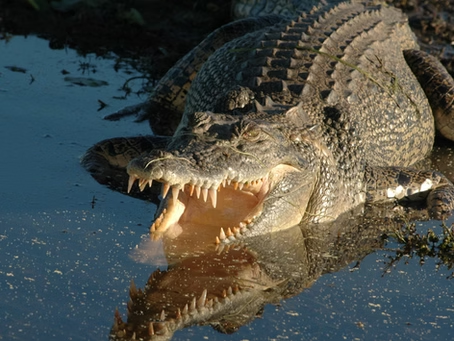Saltwater Crocodile Overview
The Saltwater Crocodile, also known as the estuarine crocodile or saltie, is the largest living reptile on Earth. Found in Southeast Asia, Northern Australia, and surrounding islands, these formidable reptiles are apex predators that play a crucial role in maintaining ecosystem balance.
Size and Appearance
Males can reach up to 6 meters (20 feet) in length and weigh over 1,000 kilograms (2,200 pounds), while females are smaller, averaging 3–4 meters. Their powerful build, broad snout, rough scaly skin, and strong jaws make them highly efficient hunters and well-camouflaged in their habitats.
Habitat and Distribution
Saltwater crocodiles inhabit a range of environments, including mangrove swamps, estuaries, rivers, and coastal areas. They thrive in both saltwater and freshwater, spanning countries like Australia, Indonesia, Malaysia, Papua New Guinea, Thailand, and India.
Diet and Feeding Habits
These reptiles are opportunistic predators, feeding on fish, birds, mammals, and other reptiles. They employ ambush hunting techniques, patiently waiting partially submerged before striking with incredible speed. Saltwater crocodiles can also survive long periods without food, conserving energy during scarce seasons.
Reproduction and Life Cycle
Females build vegetation nests near water to lay 40–60 eggs. Incubation lasts about 90 days, during which mothers guard the nests. Hatchlings face numerous predators and challenges, with only a small percentage surviving to adulthood. Sexual maturity takes years, highlighting the species’ slow reproductive rate.
Behavior and Adaptations
Saltwater crocodiles are aggressive and territorial. They regulate body temperature by basking or submerging in water, use powerful jaws for hunting, and perform ambush attacks and death rolls to subdue prey. Their strong swimming abilities, keen eyesight, and sensitive skin make them efficient apex predators.
Comparison with Other Crocodile Species
- Size: Saltwater crocodiles are the largest, up to 6 meters, while Nile and American crocodiles average 4 meters.
- Habitat: Salties occupy both freshwater and marine areas; Nile crocodiles prefer rivers/lakes, American crocodiles prefer brackish/coastal waters.
- Diet: Saltwater crocodiles take larger prey, including mammals and reptiles, while others feed mainly on fish and amphibians.
- Behavior: Highly territorial and social in groups, unlike many solitary crocodile species.
Interesting Facts
- They are the largest living reptiles, capable of growing over 6 meters.
- Saltwater crocodiles are expert ambush predators, using stealth, patience, and powerful strikes.
- They are survivors from the dinosaur era, demonstrating remarkable adaptability.
- These reptiles can live over 70 years in the wild, growing rapidly in early years.
Conservation Status
Listed as least concern on the IUCN Red List, saltwater crocodiles face local threats from habitat loss, poaching, and human-crocodile conflicts. Conservation measures include protected areas, anti-poaching laws, and community engagement to ensure survival and ecosystem balance.
Conclusion
The Saltwater Crocodile is a powerful, adaptable apex predator with impressive size, hunting abilities, and longevity. Respecting their space and conserving their habitats ensures these incredible reptiles continue to thrive in the wild.

